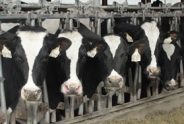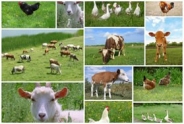Dairy farming essentials: How to infuse intramammary medications
Camila Lage, Dairy Management Specialist
Southwest New York Dairy, Livestock and Field Crops Program

Dairy farming essentials: How to infuse intramammary medications
Mastitis continues to be the costliest disease of dairy cattle. Antibiotic therapy still plays an essential role in the control of mastitis in dairy cows. Treatment during lactation is not effective in all mastitis cases. Therefore, dry cow therapy is still an essential tool to eliminate previous infections and prevent new cases of mastitis.
Since the development of blanket therapy, a lot has changed. Many farms in the US have eliminated Strep. Ag. and S. aureus from their herd and improved their milk quality significantly. It's not rare to see herds with BTSCC's of 150,000 or lower. In this context, and with growing public concern over antibiotic usage in farms, there's been an increase in the use of selective dry cow therapy (For more information about selective dry cow therapy, read this). For herds using this approach, teat sealants play an important role by preventing new infections without relying on antibiotics.
Although mastitis treatments might be changing, it is essential to remember that: how we infuse intramammary medications on our cows matters. A careful procedure is critical to achieve desired results. Although relatively a simple technique, it is essential to remember this important principle: Teats need to be clean and dry. The only thing that can enter the teats is a sterile cannula and the drug. If the process is not done correctly, we can cause mastitis by inadvertently introducing microorganisms through the teat canal.
The best procedure is to follow these easy steps (Source: NMC):
- Use CLEAN gloves during the process.
- Dip teats in an effective germicidal product. Allow 30 seconds of contact time before wiping tears with an individual, disposable towel.
- Thoroughly clean and disinfect each teat end Scrub the teat opening with a cotton swab soaked in 70% alcohol. Use a separate swab for each teat.
- Prepare teats on side farthest from you first, followed by teats on the near side. (Teats may be cleaned and infused individually, if necessary.)
- Treat quarters in reverse order; near side first, far side last.
- Insert only the tip of the cannula into the teat end and express all the contents. Do not allow the sterile cannula to touch anything before infusion.
- Do not massage the teats to disperse the product.
- Dip teats in an effective germicidal product after treatment.
- Identify/mark treated cows and remove them from the milking herd to prevent antibiotics from entering the milk supply.
Sanitizing the teats is necessary even if treatment is administered immediately after milking. Although the udder and teats appear clean from your pre-milking routine, the teat end can be contaminated with mastitis-causing bacteria after milking. These microorganisms could be carried into the teat canal along with the infusion cannula if not correctly disinfected during the process. In addition, always dip gloved hands in a sanitizing solution between treating individual animals to reduce the spread of pathogens.
Avoid fully inserting the conventional mastitis tube syringe cannula. This could result in temporary dilation of the teat sphincter muscle, allowing the entry of microorganisms. The syringe cannula may also push microorganisms that are colonized in keratin into the teat cistern.
For more information, check out these procedures for intramammary treatment in dairy cows by clicking on the pdf located on the bottom of this page
This information is for educational and reference purposes only and is not a substitute for sound veterinarian consultation and following product labels. Cornell Cooperative Extension is dedicated to providing research-based information to our agricultural producers. Every effort has been made to provide correct, complete, and up-to-date recommendations.
Procedures for Intramammary Treatment in Dairy Cows (pdf; 1018KB)
Upcoming Events
Crops, Cows & Critters - Southwest New York Dairy, Livestock & Field Crops Newsletter Sponsorship
December 19, 2025
Our two forms of publications feature research-based and timely information from our four specialists, listed to the right, along with local event notifications and Cornell University outreach. This information is provided to participants who range from dairy, livestock, and field crops producers to agricultural suppliers and consultants.
Weekly Email Update: Shared with 625+ households who have signed up with our program.
Monthly Paper Mailer: To reach our stakeholders and farmers who lack internet access, we send out a monthly mailer where your company's logo and contact information would be featured with a mailing list of 330+ households.
If you sponsor our weekly and monthly publications you reach approximately 955 households.
Visit our website to view our newsletters!
2025 Cornell Food Beverage & Animal Feed Manufacturer Survey
December 19, 2025
Industry and Educational Advocates for New York State's Food, Beverage, and Animal Feed Manufacturing industries:
As you know, NYS has a diverse food and beverage manufacturing industry, in both the types of industries that exist and the wide distribution of firms by scale. Many manufacturing firms have strong backward linkages to agricultural production sectors in the state that support both farm-level and downstream food industry firms and consumers. In collaboration with the New York State Department of Agriculture and Markets, a team from Cornell University's Charles H. Dyson School of Applied Economics and Management has recently rolled out the 2025 New York State Food, Beverage, and Animal Feed Manufacturer Survey. The industry will benefit from an updated assessment of the industry that informs private and public investments and opportunities to support firm growth and improved profitability.
Cornell Organic Field Crops & Dairy Conference
March 6, 2026
Waterloo, NY
Farmers, researchers, educators, and agricultural service providers from across the Northeast are invited to the 2026 Cornell Organic Field Crops & Dairy Conference, held Friday, March 6, 2026, from 8:00 a.m. to 4:30 p.m. at the Lux Hotel & Conference Center in Waterloo, N.Y.
Co-hosted by New York Soil Health and Cornell CALS, the annual conference brings together leaders in organic grain, dairy, and livestock systems to share practical tools, new research, and farmer-tested strategies to support resilient and profitable organic production.
Announcements
No announcements at this time.





